Please Report Any Broken Links Or Trouble You Might Come Across To The Webmaster.
Please Take A Moment To Let Us Know So That We Can Correct Any Problems And Make Your Visit As Enjoyable And As Informative As Possible.
| Click On Image For Full Size Image | Size | Image Description | Contributed By And/Or Copyright |
|
|---|---|---|---|---|
| February 1940 - October 1942 / Building & Fitting Out |
||||
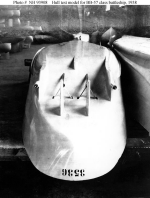 |
76k | Hull test model for the South Dakota class (BB-57 - 60) battleships. Hull model number 3536, photographed at the Experimental Model Basin, Washington Navy Yard, Washington, D.C., in 1938. Note the widely spaced skegs, supporting the outboard propeller shafts, that were a unique feature of this battleship class. Copied from the Bureau of Ships monograph "United States Battleship Designs for World War II", dated 1 June 1946. | Naval History and Heritage Command # NH 93908, from the collections of the Naval Historical Center. | |
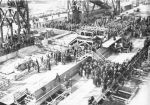 | 141k | 1 February 1940 photo of the keel laying for Alabama (BB-60) at the Norfolk Navy Yard, Portsmouth, Virginia. | Official USN photo courtesy of Mike Green / Leeward Publications "SHIP'S DATA". |
|
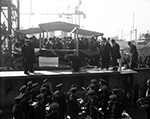 |
717k | 1 February 1940 photograph of the laying of the keel ceremony for the Alabama (BB-60) at the Norfolk Navy Shipyard in Portsmouth, Virginia. In this photograph dignitaries are driving rivets into the keel of the battleship. | Photo from The Virginian-Pilot Photograph Collection / SMC Photograph Collection from the Norfolk Public Library (Va.) | |
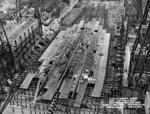 |
20.07k | 11 photo PDF of the Alabama (BB-60) on building ways, 2 April 1940 thru September 1941. | Norfolk Navy Yard photos courtesy of Pieter Bakels. | |
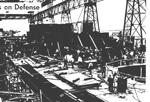 |
NR | Out of this welter of great steel plates and busy workmen will emerge the 35,000-ton battleship Alabama (BB-60) as the dreadnought "grows" far ahead of schedule at the Norfolk Navy Yard, this view is over the forward part of the main deck. She is now scheduled for launching early next year. | Image and text provided by Library of Congress, Washington, DC. Photo from Evening Star. [volume] (Washington, D.C.) 1854-1972, 28 September 1941, Image 111, courtesy of chroniclingamerica.loc.gov. | |
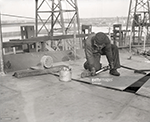 |
571k | (Original Caption) 10/23/1941-Norfolk, VA: and here is a new note in battleship building. While riveters bang away on the deck plates of the Alabama (BB-60), a loud speaker nearby gives out the latest music - sweet and good. The music is broadcast throughout the great construction job via speaker system from a phonograph. The Alabama is a sister ship to the North Carolina (BB-55). She will be launched in Febuary, 1942, at Norfolk Navy Yard. | Photo by Bettmann via Getty Images courtesy of gettyimages.com. | |
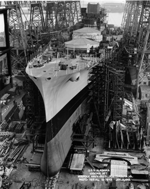 |
3.63k | Looking aft, 4 January 1942. | Norfolk Navy Yard photo # 10-79-43, courtesy of Pieter Bakels. | |
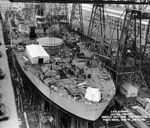 |
5.77k | Looking forward, 4 January 1942. | Norfolk Navy Yard photo # 10-80-44, courtesy of Pieter Bakels. | |
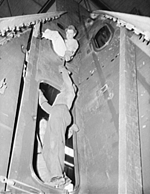 |
64k | Shipbuilding (Norfolk Navy Yard). This is one one-thousandth of the manpower engaged in the construction of Uncle Sam's new $70,000,000 battleship, the Alabama (BB-60), which is scheduled to be launched in February, 1942. Approximately 3000 men are working to complete this mighty mistress of the seas. The men above are skilled ship fitters. | Library of Congress # LC-USE6-D-001672, courtesy of Mike Green. | |
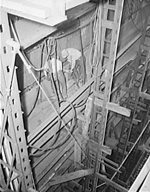 |
83k | Shipbuilding (Norfolk Navy Yard). These men are putting in some of the hundreds of thousands of rivets on the huge 70 million dollar battleship Alabama (BB-60), under construction at the Norfolk Yard. The ship is scheduled for launching in February 1942 | Library of Congress # LC-USE6-D-0017, courtesy of Mike Green. | |
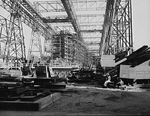 |
101k | Behind the scaffolding is one of the most powerful ships ever built, the Alabama (BB-60), which is scheduled to be launched in February, 1942. This 70 million dollar super dreadnought is one of several powerful additions to Uncle Sam's rapidly growing fleet under construction at the Norfolk Navy Yard. | Library of Congress # LC-USE6-D-001701, courtesy of Mike Green. | |
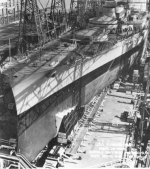 | 184k | Alabama (BB-60) is seen on 15 February 1942, the day before launching. The ways are cleared, the launching platform is in position and the poppet is in position under the bow. Note the sign on the front of the poppet, for the benefit of newsreel cameras at the Norfolk Navy Yard, Portsmouth, Virginia. | Official USN photo courtesy of Mike Green / Leeward Publications "SHIP'S DATA". | |
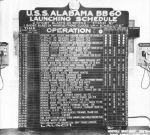 | 186k | Launching schedule board for the Alabama (BB-60). The 12-hour launching sequence involved 36 precisely timed operations, including removal of various shoring which were all color coded to insure their removal in correct order. | Official USN photo courtesy of Mike Green / Leeward Publications "SHIP'S DATA". | |
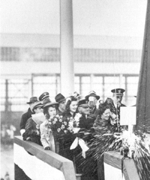 |
273k | Mrs. Lister Hill, wife of the senior Senator from Alabama christens the Alabama (BB-60) on 16 February 1942 at the Norfolk Navy Yard. | USN photo courtesy of Scott Koen & ussnewyork.com. | |
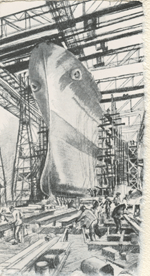 |
402k | Alabama (BB-60) Launch Program, etc. | Photo courtesy of Ron Reeves (of blessed memory). | |
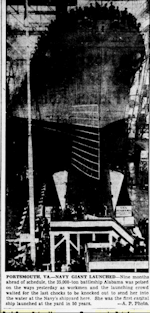 | NR | PORTSMOUTH, VA.—NAVY GIANT LAUNCHED — Nine months ahead of schedule, the 35,000-ton battleship Alabama (BB-60) was poised on the ways yesterday as workmen and the launching crowd waited for the last chocks to be knocked out to send her into the water at the Navy's shipyard here. She was the first capital ship launched at the yard in 50 years. | Image and text provided by Library of Congress, Washington, DC. Photo & text by Evening Star. [volume] (Washington, D.C.) 1854-1972, 17 February 1942, Image 4, courtesy of chroniclingamerica.loc.gov. | |
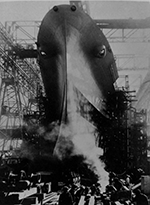 |
1.27k | Another Mighty Battleship. The mighty 35,000 ton battleship, Alabama (BB-60), shown at Norfolk Navy Yard, Portsmouth, Virgini, just before she was launched, 16 February 1942. |
USN photo # Lot-9437-5, courtesy of the National Museum of the U.S. Navy, courtesy of flickr.com. | |
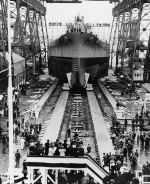 | 158k | Launching of the Alabama (BB-60) at the Norfolk Navy Yard, Portsmouth, Virginia, 16 February 1942. | Naval History and Heritage Command # NH 75608, now in the collections of the National Archives. | |
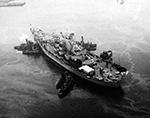 | 587k | An aerial oblique view of the Alabama (BB-60) after launching at Norfolk Navy Yard, Norfolk, Virginia, 16 February 1942. | USN photo # 80-G-464255 courtesy of National Museum of the U.S. Navy via flickr.com. | |
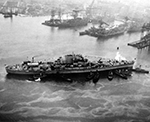 | 731 | An aerial oblique view of the Alabama (BB-60) after launching at Norfolk Navy Yard, Norfolk, Virginia, 16 February 1942. | USN photo # 80-G-464258 courtesy of National Museum of the U.S. Navy via flickr.com. | |
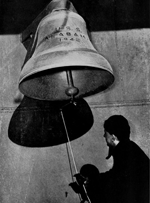 | 95k | A steel southern belle for the Alabama (BB-60). | Photo from the War Diary USS Alabama 1942 - 1944 via Bill Gonyo. | |
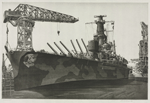 | 148k | A print by the artist John Taylor Arms: from the U.S. Navy Series No. 1: Battle Wagon - Alabama (BB-60) Outfitting at Norfolk Navy Yard, Crane Ship Kearsarge (AB-1) Alongside-1942. | Courtesy of Stephen F. Fixx, Cleveland Museum of Art. | |
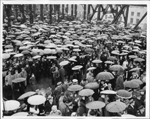 |
316k | Crowd at Alabama (BB-60) launching. | USN photo courtesy of Ron Reeves (of blessed memory). | |
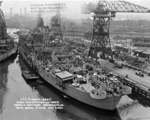 |
6.85k | Stern view at fitting out berth, 3 July 1942. The ex-battleship Kearsarge (AB-1) is moored next to the Alabama (BB-60) for lifting the 16" gun barrels into place. Main and secondary gun turrets are being fabricated and the smoke indicates that some of the boilers have been lit off. |
Text courtesy of of Mike Green from Leeward Publications/ SHIP'S DATA 2 and (2 & 3) Naval Supply News, Volume 5, No. 18, 6 September 1946 by the U.S. Naval Station at Seattle, Washington. Norfolk Navy Yard photo # 10-172-48, courtesy of Pieter Bakels. | |
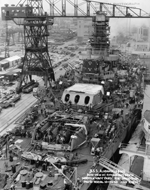 |
7.12k | Bow view at fitting out berth, 3 July 1942. | Norfolk Navy Yard photo # 10-174-50, courtesy of Pieter Bakels. | |
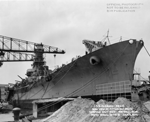 |
5.37k | Bow view at fitting out berth, 3 July 1942. | Norfolk Navy Yard photo # 10-175-51, courtesy of Pieter Bakels. | |
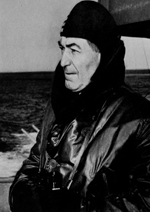 | 70k | Capt. George Barry Wilson, 16 August 1942 – 17 March 1943. | Photo from the War Diary USS Alabama 1942 - 1944 via Bill Gonyo. | |
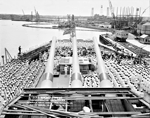 016029 | 2.05k | After nearly 2 & 1/2 years of construction, the commissioning of the South Dakota-class battleship Alabama (BB-60) takes place at Norfolk Navy Yard. She is berthed at the uncompleted Pier 6, on 16 August 1942. In the foreground, note the open top of turret# 3 on Alabama.
In the distance on the left, note center swing span on Beltline Railroad Bridge, in the extreme distance you can see the uprights of the now-gone Jordan Bridge. Note the small rail crane to right of the bow, as dredging of the turning basin and construction of Dock# 8 & Berth 42/43 continued. | Norfolk Navy Yard photo 10-179. Photo Credit: Marcus W. Robbins, Norfolk Naval Shipyard Historian and Archivist courtesy of Brian Baird. | |
| November 1942 - March 1943 / Shakedown Cruise |
||||
 | 62k | Underway in Chesapeake Bay, 30 November 1942. | USN photo. | |
 | 1.61k | Alabama (BB-60) in Casco Bay, Maine, during her shakedown period, circa December 1942. Note her Measure 12 (modified)Atlantic camouflage scheme. | Official USN photo Naval History and Heritage Command # 80-G-K-445, submitted by Tracy White @ Researcher @ Large. | |
 | 600k | Underway off Casco Bay, Maine, during her shakedown period, December 1942. | Official USN photo submitted by David Buell. | |
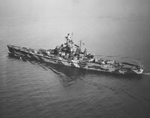 | 370k | Just making headway while underway off Casco Bay, Maine, during her shakedown period, December 1942. | Official USN photo submitted by David Buell. | |
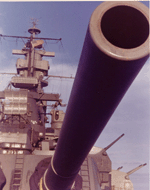 | 442k | Closeup view of the left 16"/45 gun of her after turret, with her superstructure beyond. Photographed during her shakedown period, circa December 1942. Note: Ladders on turret faceplate; Mk.8 and Mk.4 fire control radar antennas atop her after gun directors. | Official USN photo Naval History and Heritage Command # 80-G-K-497 courtesy of Pieter Bakels. | |
 | 344k | A cold & colorful Alabama (BB-60) during shakedown. | USN photo courtesy of Pieter Bakels. | |
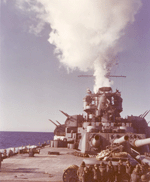 | 381k | Looking from the rear turret of the Alabama (BB-60) amidst the rising steam from her stacks. | USN photo courtesy of Pieter Bakels. | |
 | 268k | Alabama (BB-60) anchored at Lynnhaven in Hampton Roads, on 1 December 1942. | Text i.d. via Brian Baird. Courtesy of Mike Green, from Leeward Publications SHIP'S DATA. |
|
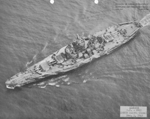 | 1.60k | 1 December 1942 photo of the ship at sea, on duty. Note the two empty gun tubs on the main deck beside the aft superstructure between Turret 3 and the secondary battery. These were each for a quad 40mm Bofors mount which were in short supply at that time. | Photo courtesy of David Buell. | |
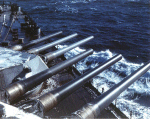 | 152k | Ship's forward 16"/45 guns train to starboard during a North Atlantic battle practice. Photographed during her shakedown period, circa December 1942 - January 1943. Note: Ice and snow on turrets and decks. | Official USN photo Naval History and Heritage Command # 80-G-K-9410, now in the collections of the National Archives. | |
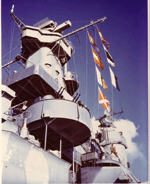 | 490k | View of the ship's forward superstructure, looking up from the port side during her shakedown period, circa December 1942. Note: Signal flags; Mk.8 fire control radar on Mk.38 main battery gun director (at top); Mk.4 fire control radar on Mk.37 secondary battery gun director at right; radio direction finder "loop" at left. | Official USN photo Naval History and Heritage Command # 80-G-K-495, courtesy of Pieter Bakels. | |
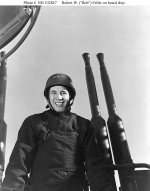 | 53k | Chief Specialist Robert William ("Bob") Feller, by a 40mm quadruple anti-aircraft gun mount, probably on board Alabama (BB-60) in late 1942 or early 1943. The original caption (released 5 March 1943) reads: "GUN CAPTAIN FELLER -- Bob Feller, one of the finest baseball pitchers of the era, is all set to do a different kind of pitching these days. As a Chief Specialist, he is the captain of a 40mm gun crew aboard one of Uncle Sam's new battleships. The former American Leaguer joined the U.S. Navy as a physical education instructor and later applied for Gunnery School. Subsequently he was assigned to sea duty and here he is -- grin and all -- beside his guns on a cold winter day." | Official USN photo Naval History and Heritage Command # NH 102847, from the "All Hands" collection at the Naval Historical Center. | |
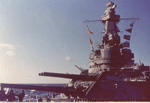 | 505k | January 1943 with the crew manning 20mm anti-aircraft. | USN photo courtesy of Pieter Bakels. | |
 | 117k | An OS2U Kingfisher about to be launched. Note the life rafts stored under the catapult (when it is stowed) and the boats on dollies. Circa January 1943. | USN photo. | |
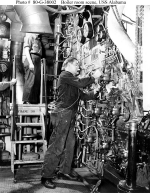 | 160k | Fireman puts on a burner on one of the ship's boilers. Taken during her shakedown cruise, circa January 1943. | Official USN photo Naval History and Heritage Command # 80-G-38002, now in the collections of the National Archives. | |
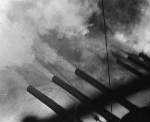 |
132k | Note: The following 20 photos were in the files titled "New Battleship Publicity Pictures". Based on the date of release and a few of the photos it could be Alabama (BB-60) on her shakedown cruise. Sixteen-Inch Salvo – In a huge, fantastic mass of searing flame and smoke, the six forward 16-inch guns of a U.S. Battleship unleash their tons of destruction. Photo distribution date 30 January 1943. |
USN photo # GE-GF-25-40438, courtesy of Darryl L. Baker. | |
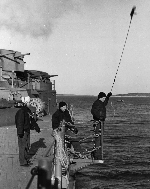 |
190k | Soundings – Despite all the modern scientific inventions, sailors still use a hand lead on a new U.S. Battleship to measure the depth of the water as the big floating fortress heads cautiously into port. Fathoms are called out to the man with the headset who in turn relays the measurement to the bridge over the intercommunication system. | USN photo # GS-DS-41-40441, courtesy of Darryl L. Baker. | |
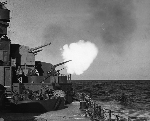 |
153k | Battle Practice – Dual purpose 5"/38 emit a dense cloud of white smoke which hangs momentarily over the muzzles during practice firing on a U.S. Battleship. These fast-firing cannon send their shells high in the air to explode and scatter fragments over a large area. | USN photo # GE-GF-25-40442, courtesy of Darryl L. Baker. | |
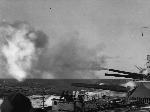 |
134k | Gun Blast – A 16-inch cannon erupts smoke and flame as it sends its lethal cargo hurtling toward the horizon during firing practice aboard one of the U.S. Navy's big battle-wagons. | USN photo # GE-GF-29-40443, courtesy of Darryl L. Baker. | |
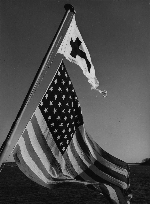 |
143k | Symbols of Right – The only pennant to fly above Old Glory is the Church pennant which is two-blocked over the National Ensign during Church services aboard ship. Here the two ripple lazily in the breeze high above the deck of a U.S. Battleship. | USN photo # NA-FP-33-40444, courtesy of Darryl L. Baker. | |
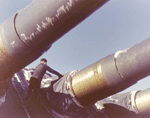 |
417k | Ice on the Bloomers – Bloomers are Navy jargon for the protecting canvas covers which fit about the barrels of the 16-inch guns where the giant weapons emerge from the barbette. Note the marks of the cannon's estimated four-foot recoil on the barrel. | USN photo # GS-I-7-40445, courtesy of Pieter Bakels. | |
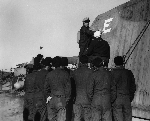 |
162k | "E"for Excellent – While members of the gun crew cluster around, a sailor paints a big "E"on one of the forward turrets of a U.S. battleship. The coveted "E"denotes an excellent performance. | USN photo # NA-INS-68-40446, courtesy of Darryl L. Baker. | |
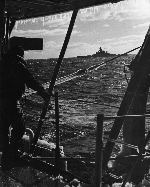 |
223k | Battle-wagon – Silhouetted against a cold, gray sky, a new U.S. Battle-wagon steams out on a mission. The picture was taken from the deck of an accompanying destroyer by a Navy Photographer. For release at 10a.m. Saturday, February 6, and anytime thereafter. | USN photo # GS-SIL-40-40458, courtesy of Darryl L. Baker. Distribution Date 2/1/43. | |
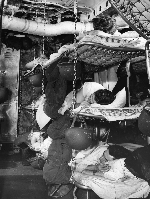 |
253k | Forty Winks – U.S. sailors aboard a U.S. Battleship grab 40 winks of sleep during their off watch below. Note the bucket helmets and "mae west" hanging on the bed ready for instant use should General Quarters sound. | USN photo # GS-BD-14-40459, courtesy of Darryl L. Baker. | |
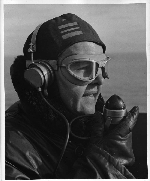 |
71k | Air Defense Officer – On the top-most platform of a battleship, known as the Sky Lookout, a U.S. Navy Officer, Lieutenant Commander, directs the fire of the 40mm & 20mm anti-aircraft guns. He must coordinate the defense fire against attacking enemy planes coming in from several directions simultaneously. | USN photo # T-COM-4-40460, courtesy of Darryl L. Baker. | |
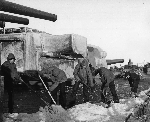 |
202k | Always Work To Be Done – If it is not scrubbing the deck down in the summer, it's cleaning off the snow in the winter, so there are few idle moments aboard a battleship. Frozen salt spray on the turrets glistens in the morning light as the men attack the snow and ice with vigor. | USN photo # GS-I-6-40461, courtesy of Darryl L. Baker. | |
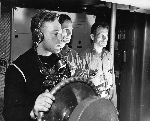 |
199k | Steering – A second class seamen takes his turn at the steering wheel of a U.S. Battleship while a first class seamen and chief petty officer watch their gauges. | USN photo # GS-BS-25-40462, courtesy of Darryl L. Baker. | |
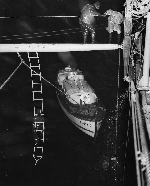 |
171k | Man Overboard – Plunged into icy water when he tumbled off the deck of a U.S. Battleship, this sailor was saved by a line and life preserver quickly thrown to him. He's holding on for dear life as his mates work swiftly to get him back aboard. | USN photo # NA-RES-24-40463, courtesy of Darryl L. Baker. | |
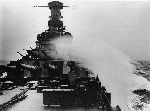 |
141k | A Mighty Ship on a Mighty Ocean – Partially shrouded by fighting spray, a new U.S. Battleship steams steadily ahead through cold, heavy seas. Sixteen-inch rifles jut out from the two forward turrets while dual-purposes batteries point skyward from amidships. Date 2/14/43. | USN photo # GS-RS-52-40464, courtesy of Darryl L. Baker. | |
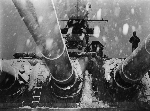 |
201k | Cold Watch – Blobs of snow falling from a leaden sky have distorted the superstructure of this new U.S. Battleship and crusted the barrels of its giant 16-inch rifles. It's a cold watch for the sailor at right. | USN photo # GS-I-7-40465, courtesy of Darryl L. Baker. | |
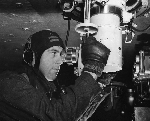 |
92k | Getting the Range – The captain of a gun crew on a U.S. Battleship looks through the periscope to get a true bearing on the target. | USN photo # GE-GC-15-40466, courtesy of Darryl L. Baker. | |
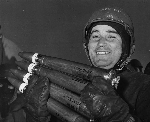 |
76k | Lethal Load – This clip of 40mm. Shells, carried by the gun crew chief on a U.S. Battleship, is ready to be loaded into a Bofors anti-aircraft gun. | USN photo # GE-GC-16-40467, courtesy of Darryl L. Baker. | |
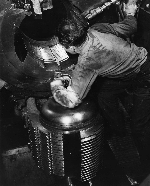 |
193k | Looking Into The Breech – This gunner on a U.S. Battleship looks through the breech-block of one of the big 16-inch guns. His left elbow rests on the "mushroom"of the gun, which he keeps clean by rubbing it with the towel wrapped around his arm. | USN photo # GE-GC-17-40468, courtesy of Darryl L. Baker. | |
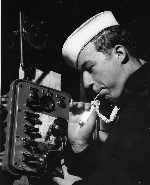 |
143k | Call to Battle Stations – A bosun's mate on a U.S. Battleship pipes the crew to attention over the loudspeaker system, just before General Quarters is sounded. | USN photo # NA-COM-2-40474, courtesy of Darryl L. Baker. | |
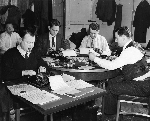 |
215k | Seagoing Typewriter Strategists – Quartered in the Admiral's cabin aboard a new U.S. Battleship, these four representatives of the nation's great news agencies had a first-hand opportunity to cover the Navy in its own element. Left to right; Sandor S. Klein, United Press; William Pickens, Transradio Press Service; Hamilton Faron, © Associated Press , and Joseph Bors, International News Service. These Washington correspondents, assigned to cover the Navy Department, spent several weeks afloat during battle maneuvers to observe the effectiveness of modern "floating fortresses." | USN photo # NA-HIS-10-40475, courtesy of Darryl L. Baker. | |
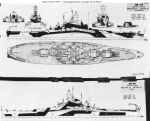 | 170k | Drawing prepared by the Bureau of Ships for Camouflage Measure 32, Design 1D intended for the battleship Massachusetts (BB-59), circa 1943. This camouflage design was not actually used on Massachusetts or any other ship of her class. | Official USN photo # 80-G-157914, from the Bureau of Ships Collection in the U.S. National Archives. | |
 | 129k | Drawing prepared by the Bureau of Ships for use in preparing camouflage designs for the Indiana (BB-58); Massachusetts (BB-59); and Alabama (BB-60), circa 1943. This plan shows the ship's starboard side, superstructure ends and exposed decks. | Official USN photo # 80-G-156818, from the Bureau of Ships Collection in the U.S. National Archives. | |
 | 60k | Drawing prepared by the Bureau of Ships for use in preparing camouflage designs for the Indiana (BB-58); Massachusetts (BB-59); and Alabama (BB-60), circa 1943. This plan shows the ship's port side. | Official USN photo # 80-G-156819, from the Bureau of Ships Collection in the U.S. National Archives. | |
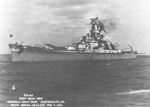 | 437k | A poor job of censoring the radar was done. Port bow view at Norfolk Navy Yard, 7 February 1943. | USN photo # N-3253 submitted by David Buell. | |
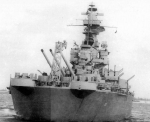 | 50k | Stern view of the Alabama (BB-60) while anchored in Chesapeake Bay, February 1943. | USN photo. | |
 | 1.39k | March 1943 in the Atlantic. The B turret is trained all the way aft to port. | National Archives photo # N-3257 courtesy of Pieter Bakels. Photo i.d. courtesy of David C. Nilsen, CTR USA, TRADOC. |
|
 | 41k | USN photo taken on 4 March 1943 in rough seas showing characteristic "wet bow" condition of the South Dakota class (BB-57 - 60) . | USN photo. Text courtesy of Mike Green. |
|
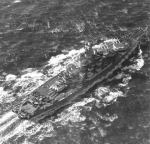 | 119k | USN photo of aerial view of Alabama (BB-60), as seen on 4 March 1943. | USN photo # 66983, courtesy of Mike Green. | |
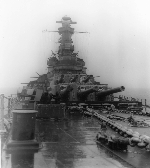 |
214k | View looking aft from the bow during a snowstorm. Crew members of the Alabama (BB-60) work in frigid conditions while on duty with the British Fleet in the North Atlantic. Photo shows the forward section of the ship, with ice/snow on her anchor chains, 4 March 1943. | USN photo courtesy of Pieter Bakels. | |
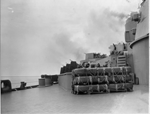 |
382k | 20mm target practice while underway with Alabama (BB-60) and HMS Duke of York. | USN photo courtesy of Phil Hayes via Pieter Bakels. | |
| April 1943 - July 1943/ War in the Atlantic |
||||
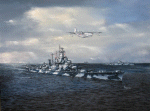 | 450k | The Alabama (BB-60) operating with the British fleet in April 1943. In the background is the battleship HMS Anson and the aircraft carrier HMS Indomitable. The airplane overhead is a Short Sunderland MKIII. | Photo and text courtesy of artbywayne.com | |
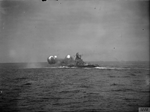 |
435k | Alabama (BB-60) firing her 16 inch guns during combined British and American fleet exercises in May, 1943. The photograph was taken from the battleship HMS Anson. | Source: Imperial War Museum Admiralty Official Collection by Hampton, J.A. (Lt), Photo No. © IWM (A 17629) via Mike Green. | |
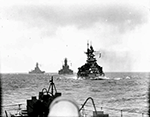 |
370k | HMS Malaya with South Dakota (BB-57) and Alabama (BB-60) following astern in May, 1943. The three ships are astern of the HMS Anson and are participating in British Home Fleet exercises. | Source: Imperial War Museum Admiralty Official Collection, by Mason, H.A. (Lt), Photo No. © IWM (A 16981) via Mike Green. | |
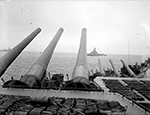 |
368k | Alabama (BB-60) anchored in Scapa Flow on 22 May 1943, as seen from the South Dakota (BB-57). | Source: Imperial War Museum Admiralty Official Collection by Hudson, F.A. (Lt), Photo No. © IWM(A 16991) via Mike Green. | |
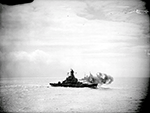 |
371k | Alabama (BB-60) firing main guns to port during participation in combined American-British Fleet exercises in June, 1943. The HMS Anson is in the background. | Source: Imperial War Museum Admiralty Official Collection, by Mason, H.A. (Lt), Photo No. © IWM (A 17581)via Mike Green. | |
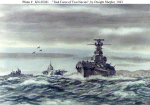 | 91k | "Task Force of Two Navies" Watercolor by Dwight Shepler, USNR, 1943, depicting U.S. and British warships in the Pentlant Firth during an operation toward the Norwegian coast, coincident with the Sicily invasion, July 1943. Alabama (BB-60) is in the lead, followed by HMS Illustrious and HMS King George V . Three British carrier-based fighters (two "Seafires" and a "Martlet") are overhead. | Official USN photo Naval History and Heritage Command # KN-20381, courtesy of the U.S. Navy Art Collection, Washington, DC, now in the collections of the National Archives. | |
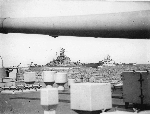 | 677k | South Dakota (BB-57) underway with Alabama (BB-60) as viewed from H.M.S. King George V. In July 1943 Alabama participated in Operation Governor, a diversion aimed toward southern Norway, to draw German attention away from the real Allied thrust, toward Sicily. It had also been devised to attempt to lure out the German battleship Tirpitz, the sister ship of the famed, but short-lived, Bismarck, but the Germans did not rise to the challenge, and the enemy battleship remained in her Norwegian lair. | USN photo courtesy of Pieter Bakels. Text courtesy of DANFS. |
|
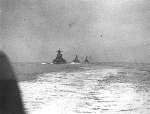 | 379k | Form Line of Battle!!! - The South Dakota (BB-57), Alabama (BB-60) and H.M.S. Anson sail in line ahead during combined operations in the Northern Atlantic in 1943. | USN photo courtesy of Pieter Bakels. | |
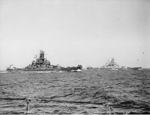 | 1.07k | The South Dakota (BB-57) & Alabama (BB-60) during combined operations in the Northern Atlantic in 1943. | USN photo courtesy of Pieter Bakels. | |
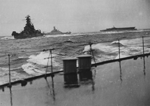 |
417k | South Dakota (BB-57) and Alabama (BB-60), 1943, with the Br. Home Fleet in the Atlantic. | USN photo courtesy of Pieter Bakels. | |
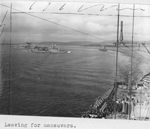 |
769k | Alabama (BB-60) & South Dakota (BB-57) at Scapa Flow. Leaving for maneuvers. Proceeding through the sub nets to the sea. |
USN photo # 80G-319289 (319291 insert) from National Archives and Records Administration (NARA), College Park, Maryland, courtesy of Sean Hert. | |
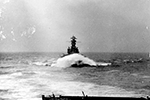 |
338k | Huge bow wave of the Alabama (BB-60), as seen from the HMS Illustrious in August, 1943. The Alabama and the Illustrious are both serving together in the North Sea as part of British Home Fleet operations. Alabama was detached from the British Home Fleet on 1 August 1943, and, in company with South Dakota and screening destroyers, sailed for Norfolk, arriving there on 9 August. | Text courtesy of DANFS. Source: Imperial War Museum Admiralty Official Collection, Photo No. © IWM (A 20640) via Mike Green. | |
| To Alabama, Very Well Done |
||||
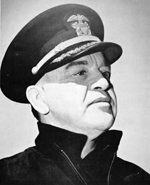 |
149k | On 20 March 1943, Captain Fred D. Kirtland, USN, relieved Capt. Wilson as skipper of Alabama (BB-60). It was under Capt. Kirtland's conn that the ship completed a tour of duty protecting lend-lease convoys to Britain and Russia, while operating with the British Home fleet in the "Murmansk Run". After a brief overhaul and repair the ‘Bama' was on her way to the Pacific. Her first major Pacific engagement was in the Gilbert Islands in November and December 1943. Her next trip was a sortie against Truck Island followed by the Marianas. Her next engagement was north of New Guinea into the Philippine Sea as a participant in the Marianas "Turkey Shoot". In August 1944 while undergoing an 18 day logistics period at Eniwetok, Captain Vincent R. Murphy, USN, relieved Captain Kirtland as commanding officer of Alabama. One unknown story of World War II concerns the role of the battleship Alabama (BB-60) in alerting Task Force 58 to a force of attacking enemy aircraft 60 years ago in the Battle of the Philippine Sea, commonly referred to as "The Marianas Turkey Shoot." Historians have consistently omitted important details and circumstances of the battleship Alabama's initial contact and report in June 1944. Early evidence either was disregarded or considered unsubstantiated. Today, however, with early documentation augmented by the action reports of the three on-scene Task Force 58.7 battle line division commanders, the Alabama's so-called claim finally can be substantiated. In August 1943, a new, improved SK air-search radar was to be fitted on the Alabama , but because of a time constraint and the need for the two battleships of Battleship Division Nine (the Alabama and South Dakota (BB-57) in the Pacific, installation could not be accomplished. Thus, Captain Fred D. Kirtland had the equipment loaded aboard, with plans to install it at Pearl Harbor. A few hours into the Pacific Ocean from the Panama Canal, Captain Kirtland announced that instead of going to Pearl Harbor, we would proceed to an advanced base at Havannah Harbor, Efate, in New Hebrides. The ship's radar pedestal was high on the mast, about 130 feet above the water line, with the mast extending about 30 feet higher. Normally, such installation requires use of navy-yard cranes, but Alabama crewmen and crewmen from a nearby repair ship muscled block-and-tackle to dismount the original air-search radar and install and calibrate the new one. This was the same radar—with the same operators—used to detect, track, and then permit reporting the approaching massive air attack force on 19 June 1944. Initially detected approximately 190 miles away, the bogie was considered by many to be an anomaly. A closing plot, the Alabama's formal 1006 report at 141 miles, and then a confirmation by the battleship Iowa (BB-61) removed any doubt of its validity. The South Dakota's description of the first attack wave at 1028, "bogey now covers an area of four miles,"indicated this contact was highly unusual. The Alabama's action report from that day cited the various reports of enemy surface force sightings and estimates of their progress toward the Marianas area: On the morning of 19 June 1944, this vessel was operating as a unit of Task Group 58.7 (Vice Admiral W. A. Lee, Jr., USN, Commander Battleships, U.S. Pacific Fleet, Washington (BB-56) Flagship), and of Task Force 58 (Vice Admiral M. A. Mitscher, USN, Commander Fast Carrier Task Force, Lexington (CV-16), Flagship) engaged in support of amphibious operations against the Japanese held MARIANAS ISLANDS. Reports had indicated that enemy surface units were approaching the area from the southwest. One report received at 1900(K) on 15 June 1944 reported a large force leaving SAN BERNARDINO STRAIT. Another report received at 0318(K) 18 June gave position, course and speed of apparently the same force as of 2155(K) on 17 June. Based on these two reports it was estimated that the enemy's daylight position, 19 June, could be in the vicinity of Lat. 12-30 N., Long. 136-40 E. At 0700(K) on 19 June, a blue submarine report as of 0630(K) on 18 June confirmed the previous estimate. The enemy daylight position from Task Group 58.7 was therefore estimated to be approximately bearing 250 true, distance 410 miles, at daylight on 9 June 1944. War diary entries of Rear Admiral O. M. Hustvedt, commander of Battleship Division 7, for the hours of 0001 through 1005 of 19 June 1944 provide further amplification. Excerpts from (unnumbered) paragraphs follow: Finback (SS-231) in position 14 - 25 N. 135 - 45 E. at 2010 on 18 June had spotted searchlights. A search of the area produced negative results but Finback added that during the day of 18 June she had observed unidentified planes. It was thus increasingly evident the Japanese were approaching an area from which aerial assaults could be launched against our forces. At 0913, a report of a search plane of VP211 had a radar contact earlier, at 0115, with a large task force, presumable enemy surface units, although no word of this information was received until about 0910. One of the most compelling pieces of evidence that the Alabama was indeed the first ship to warn of the incoming bogies on 19 June 1944 was a message from Vice Admiral W. A. Lee Jr.: "In the matter of reporting initial bogies, to Iowa , well done, to Alabama , very well done." Selected entries from the Alabama's action report chronology begin with the following: 1000—Position of Alabama was Latitude 14-15-55 N., Longitude 143-00-20 E. Task Group 58.7 was disposed in Cruising Disposition 7-Roger, Axis 270, Course 250, Speed 18. 1006—Alabama made initial contact, reporting to CTG 58.7 a large bogie, bearing 268 true, distance 141 miles, angles 24 or greater, closing. CTF 58 asked for confirmation of Alabama's contact; Iowa substantiated. Selected entries from the South Dakota's action report for 19 June 1944 provide a dramatic description of the action: 1012—General Quarters sounded to repel air attack. Many bogies on the screen. Commenced forming cruising disposition 7-V, Course 250 T, speed 18 knots. 1016—Battery is manned and ready. Bogey 1 bearing 264 T, range 94 miles. 1021—Bogey 1 bearing 266 T, range 78 miles. Friendly fighters bearing 275 T, range 30 miles. Machine guns given permission to fire inside formation if elevation is above ships in line of fire. 5"(guns) may not fire inside formation. 1027—Friendly fighters have been ordered to form up at 270 T, range 30 miles. 1028—Bogey 1 bearing 269 T, range 53 to 57 miles, bogey now covers an area of four miles on this bearing. 1029—Order given to catapults to jettison bombs and depth charges. COURTESY OF THE LENOIR FAMILY Eugene S. Pennebaker, one of the two radar technical officers on board the Alabama on 19 June 1944, received the Bronze Star and this letter of commendation from Secretary of the Navy James Forrestal. 1030—Friendly planes bearing 269 T, range 39 miles. Bogey 1 bearing 268 T, range 49 miles. Bogey 2 bearing 330 T, range 59 miles. 1031—Friendly planes bearing 275 T, range 39 miles and 49 miles. Friendly fighters bearing 272 T, range 48 to 52 miles. 1032—Friendly fighters bearing 273 true, range 40 miles and 48 miles. Increased speed to 22 knots by signal. 1033—Large group of friendly planes bearing 290 T, range 48 miles. 1034—Bogie 1 bearing 270 T, range 40 to 45 miles, at altitudes from 16,000 to 21,000 feet. Sky IV is on this target, range 98,000 yards. 1035—Our fighters intercept Bogey 1. Bogey 2 bearing 282 T, range 55 miles. 1036—Merged plot on screen, bearing 275 T, range 38 miles, covering an 8 mile area. Order given to get up extra 5"ammunition. 1039—Bogies 1 and 2 bearing 282 T, range 30 to 40 miles, merged in general melee with our fighters. 1040—Bogies bearing 285 T, range 35 to 45 miles. Twenty bogies in group reported by friendly fighters. Groups of bogies began breaking through our fighters. 1042—Bogey 1 has split into two groups. Bogey 1 bearing 277 T, range 21 miles. 1043 1/2—Sky IV has bogey bearing 280 T, range 37,000 yards. Sky III has bogey at 40,000 yards. Sky I has bogey at 32,000 yards. 1044—Bogey is bearing 276 T, range 34 miles. Low flying planes on horizon off port bow. 1044 1/2—Sky II has bogey, three enemy planes visually bearing 293 T, range 29,000 yards. Bogey 1A bearing 283 T, range 13 miles. Friendly fighters are also at that position. 1045—Sky II has target, range 25,200 yards. Bogey 1A bearing 280 T, range 11 miles. Our fighters are also in that position. Crewmen on board the Alabama on 19 June 1944 were made aware the ship's radar and its operators had made the initial contact. Notes cited in the 21 June 1944 plan-of-the-day reinforced awareness: A [news] ‘Flash': Our search planes have reported the Jap Fleet in three or four groups about 250 miles to the west of us. At this writing, our Attack planes were taking off and heading for the Enemy. We may have a surface action today, Wednesday. Messages, originated after the Air Attacks Monday, are quoted below for information. From CTF 58 (Vice Admiral Mitscher) to TF 58 . . . skillful defense of this Task Force enabled the Force to escape a vicious well coordinated Aircraft Attack carried out with determination. From CTG 58.7 (Vice Admiral Lee) to TG 58.7, In the matter of reporting initial bogies, to Iowa , well done, to Alabama , very well done. From ComBatDiv 9 (Rear Admiral Hanson) to Alabama , Congratulations to you, your ship and especially to your Super Alert Radar Crew. You were in large measure responsible for yesterday's superlative Air Victory. Southwest corner was getting hot yesterday. Your help is greatly appreciated. From Alabama to South Dakota, All hands here express sympathy and hope casualties were light. From South Dakota to Alabama , Thank You. Twenty men and one officer killed. Twenty three were injured. Ten serious. One five hundred bomb struck port side at 0-1 level. Documentation that Pacific Fleet headquarters was aware of the Alabama's initial contact and considered it noteworthy appeared in U.S. Pacific Fleet, Advance Headquarters, Guam, Press Release No.182, labeled "For release at 0800 (-10), 12 August 1945." It presented brief descriptions of the Alabama's participation in various operations through to 5 June 1945. But the third paragraph of page 2 reads as follows: It was the Alabama which first gave the warning to the rest of her task force that a huge air-fleet of Japanese planes was approaching. The resulting battle, in which the Japanese force was turned back, has been called the first battle of the Philippines Sea. American carrier pilots termed the air battle a "turkey shoot." In a book published in 1999, containing statements by various crewmen on their memories of duty in the Alabama , watch officer E. Wayne Bundy commented: In any case we got bogeys first and further out than anybody else. Turkey Shoot Day off Saipan and Guam, Joe Cook and Cliff O'Brien had incoming Japanese carrier planes so far out the Flag didn't believe us. Nor our 2nd report. Nor 3rd. Finally somebody else confirmed, and they decided it was for real. (We knew that from the first blip on.) The radar officer, Captain (then-Lieutenant) John Henry, the two radar technical officers, (then Naval Reserve Lieutenants) Walter F. Lenoir Jr. and Eugene S. Pennebaker, and the two radar operators on watch that morning, O'Brien and Cook, were honored officially with commendations for their outstanding performance. In the 1960s, the late retired Army Lieutenant Colonel Stephens Croom, member and secretary of the state's USS Alabama Battleship Commission, performed extensive research and made numerous inquiries, seeking confirmation and recognition of the Alabama's initial contact report. In paragraph 2 of a 22 October 1973 letter to the then-Head, Curator Branch, Naval History Division, Washington Navy Yard, Croom states: Your suggestion that we have erred in our claim that Alabama provided "the early warning"of the enemy's approach has caused us some concern. With all due respect to [Rear] Admiral [Samuel Eliot] Morison in his decision not to credit a single ship (Alabama ) as the source of the early warning, we submit, in support of our posture, two items of official documentary evidence, plus two living eye witnesses who were on the scene. He then proceeds to detail the contents of a recommendation from Rear Admiral E. W. Hanson, commander of Battleship Division Nine, that Captain Kirtland be awarded the Legion of Merit. He cites also the telephone testimony of retired Navy Captain Henry, who recalled that the Iowa was asked to confirm the radar signal reported by the Alabama . Croom's detailed assembly of the evidence, too lengthy to reproduce here, includes recollections from retired Navy Captain Frank H. Brumby Jr., gunnery officer on board the Indiana (BB-58) on 19 June 1944. What he remembers most is his skipper's reaction when the ship's communications officer read about the Alabama's initial contact over the loudspeakers. "Dammit,"Brumby remembers him saying, "why the devil does he have to tell what other ships have done; we have our own ship to think about." At a ship's reunion in the late 1970s, Croom distributed copies of two letters he had received. One, dated 6 December 1974, was from the Navy's World War II historian, Rear Admiral Morison, and the other, dated 20 May 1975, was from the Director of Naval History and Curator for the Navy Department. Neither provided confirmation of the Alabama's initial contact, but neither gave an unqualified denial. In fact, the letter from the Navy Department concluded: "My people have done further research on the subject without uncovering contrary information. Unless or until such information comes to light, I believe it is safe to assume that Alabama was the first to detect the Japanese aircraft on this occasion." In fall 2001, a new inquiry to the Naval Historical Center yielded excerpts of action reports and war diaries for 19 June 1944 submitted by Task Force 58 battleship division commanders. Each cites the Alabama by name as having made the initial contact report. On 30 May 2002, an outline of this article was mailed to the two Alabama radar operators on watch the morning of 19 June 1944, Cook and O'Brien. Cook remembered the distance for the first contact as being approximately 175 to 178 miles distant. From first contact on, Joe and Cliff observed the blips of individual enemy planes as they flew to an assembly point at an altitude of about 25,000 feet. The size of the bogey enlarged. Few believed the contact because of the distance, but radar operators on the other ships were alerted. Their radar, however, could not pick up the image. At about 150 miles distant and with the contact tracking ever closer, Captain Kirtland became convinced of its validity and qualified it as an official report at a distance of 141 miles. When the Iowa confirmed, everyone became a believer. Shortly, other ships picked up on the bogie. At a past reunion, one of the Alabama radar operators remembered the wait for confirmation as "some of the longest minutes of my life." We frequently have seen the phrases "our radar provided early warning"and "at a distance of about 140 miles"as the lead sentences in historical descriptions of the Turkey Shoot. Other than CinCPac's Press Release 182, however, battle accounts omit comment on the considerable evidence that the Alabama had made and reported the initial contact. It would seem Admiral Morison was aware not only of the Alabama's report, its time, and distance, but also of her very first contact at about 190 miles distant. Today, with the detailed perspective of each of the battle line division commanders, substantiation is lacking for Admiral Morison's volume 8, page 263, citation of "one minute before ten o'clock . . . task force radar picked up a flock of bogies." Battle line commanders do not mention any such radar report. Except for the cited time, their reports do parallel to some degree. Admiral Morison's page 265 citation of Admiral Lee's battle line picking up the massive bogey "at 1000 when over 150 miles distant"is close. The Alabama reported at 1006 and at 141 miles distant; the Iowa confirmed at 125 miles. With no other on-the-scene battle line reference to earlier contacts, Admiral Morison's scenario, citing times before 1006, yet including the phrase "over 150 miles distant,"had to have some basis for him to extrapolate in such a manner. Historians exercise some latitude in describing the overview of a major event, such as a war. Unique actions by an individual unit that contribute significantly to the outcome would seem an important part of any description. In Admiral Morison's letter of 6 December 1974 to Croom, he included the statement: "I am quite willing to admit that I was wrong." At a minimum, his historical account was incomplete. Master Chief Spinner has been working tirelessly for years to gain the crew and officers of the Alabama the credit he says they deserve. For the sake of brevity, we have not reproduced all of his documentation here. He can back up each of his claims. By Master Chief Alvin J. Spinner, U.S. Navy (Retired) Naval History, June 2004 |
USN photo courtesy of Bill Gonyo. | |
| August 1943 - September 1945/ War in the Pacific |
||||
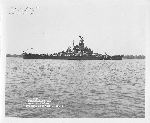 | 503k | Starboard broadside view at Norfolk Navy Yard on 20 August 1943 soon after completion of post refit trials and indicating changes to electronics which are circled. | USN photo # 5865-43, courtesy of David Buell. | |
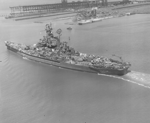 | 304k | Alabama (BB-60) dated 20 August 1943, photo taken from an altitude of 300 feet. | USN / BuAer photo courtesy of David Buell. | |
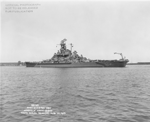 | 451k | Very clear resolution of a port quarter view of the Alabama (BB-60) at Norfolk Navy Yard, 20 August 1943. | USN / BuAer photo # 5866-43 courtesy of David Buell. | |
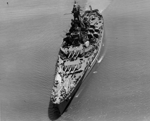 | 438k | 20 August 1943 post refit trials off Norfolk. Flag bridge is plated in, she carries ten quadruple 40mm mounts, and circle indicates enlarged radar platform for the soon to be fitted, SK-2 dish air search unit. | USN photo courtesy of Pieter Bakels. | |
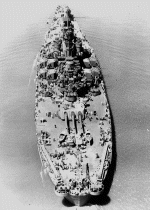 | 160k | The stern shot was taken at her 1943 refit at Norfolk, 20 August 1943. She is carrying ten 40mm quadruple A.A. mounts, her ultimate battery, at that time. She ended the war with twelve mounts and was never fitted with the new ultimate, eighteen mounts, like the Massachusetts (BB-59) carried. | Naval History and Heritage Command # NH 57498, now in the collections of the National Archives. | |
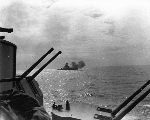 |
466k | The Alabama (BB-60) firing as viewed from the South Dakota (BB-57) on 29 October 1943. Note South Dakota's 5-Inch battery in the foreground. | USN photo courtesy of Pieter Bakels. | |
 |
175k | Gilberts Operation, November 1943. Ships of TF 50 en route to the Gilberts and Marshalls to support the invasions of Makin and Tarawa, 12 November 1943. Alabama (BB-60) photo taken by Monterey (CVL-26). Indiana (BB-58) is in the distance, camouflaged. | USN photo courtesy of Pieter Bakels. | |
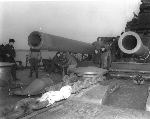 |
118k | Crew at work at one of the control stands in 1943. | USN photo courtesy of Pieter Bakels. | |
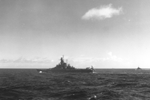 | 614k | This photo probably shows Alabama (BB-60) with accompanying destroyers in the Pacific, after she received SK radar. Late 1943-1944 period, perhaps even into early 1945 at which time she went to Puget Sound NSY and received SK-2 radar and was painted into Measure 22. | Text i.d. courtesy of David Buell. National Archives photo # 80-G-204904, courtesy of David Buell. | |
 016024 | 728k | Alabama (BB-60) and OS-2U Planes, Dcember 1943. | National Archives Identifier: 178141108 Local Identifier: 80-GK-13793 Photo courtesy of catalog.archives.gov, via Daniel Hacker. | |
 |
209k | The battleships South Dakota (BB-57), Alabama (BB-60) and North Carolina (BB-55) as seen from the Essex class carrier Intrepid (CV-11) on 25 January, 1944. | USN photo courtesy of Pieter Bakels. | |
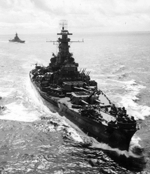 |
423k | South Dakota (BB-57) followed by Alabama (BB-60) on their way to the Marshalls to shell Roi and Namur islands on 1 February 1944. | USN photo submitted by Pieter Bakels. | |
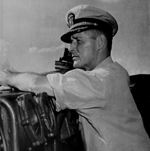 | 117k | Capt. Vincent Raphael Murphy 12 August 1944 – 14 November 1944. | Photo from the War Diary Alabama 1942 - 1944 via Bill Gonyo. | |
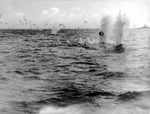 | 674k | With an unidentified destroyer and the Alabama (BB-60) in the background, a Japanese torpedo bomber (Jill) releases it's torpedo off the starboard bow of the Essex (CV-9) on 14 October 1944. | US Navy and Marine Corps Museum/Naval Aviation Museum, Photo No. 1983.046.010.034 via Mike Green. | |
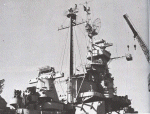 | 136k | As inclined in February 1945, the Alabama (BB-60) shows a pair of Mark 577 antiaircraft directors abaft her after main battery fire control center, as well as the vent trunking, range finder and sights of her No.3 turret. Note also the large vent just below the 40mm mount. The forward main battery fire control tower carries another of the unidentified flat antennas, just below the searchlights. The photo of her rig, dated 13 March, shows the small radome of an SU, which replaced her forward SG surface-search set. Below it is the fat radome of a TDY-1A jammer, sharing a platform with an SK-2 air search antenna. The mainmast air-search antenna is an SC-2. The spike just visible on the forward edge of the fire control tower was presumably associated with the flat-faced antenna there. | Photo & text courtesy of U.S. Battleships: An Illustrated Design History by Norman Friedman. | |
 | 113k | As inclined in February 1945, the Alabama (BB-60) shows a pair of Mark 577 antiaircraft directors abaft her after main battery fire control center, as well as the vent trunking, range finder and sights of her No.3 turret. Note also the large vent just below the 40mm mount. The forward main battery fire control tower carries another of the unidentified flat antennas, just below the searchlights. The photo of her rig, dated 13 March, shows the small radome of an SU, which replaced her forward SG surface-search set. Below it is the fat radome of a TDY-1A jammer, sharing a platform with an SK-2 air search antenna. The mainmast air-search antenna is an SC-2. The spike just visible on the forward edge of the fire control tower was presumably associated with the flat-faced antenna there. | Photo & text courtesy of U.S. Battleships: An Illustrated Design History by Norman Friedman. | |
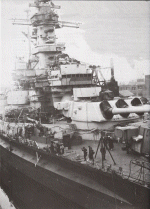 | 117k | Bridge detail shot was taken at Puget Sound in February, 1945, at her final refit. The bridge walkway has been enclosed and she is being inclined, as evidenced by the weights (cases numbered 10 and 9 on her deck). She is receiving her final 40mm A.A. addition and is being prepared to receive guns in the incomplete gun tub atop #2 turret. Her side hull recess has bolted manhole covers which provide access to her outer hull. | USN photo. | |
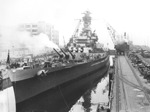 | 369k | Degaussing cables run the length of her fore deck at Puget Sound in February, 1945. | National Archives photo courtesy of David Buell. | |
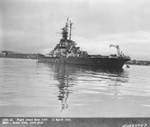 | 450k | Stern view, port side, anchored in Puget Sound following refit. Note the angles of 16 inch barrels showing their independent elevation capabilities, 15 March 1945. | USN photo # 1326-45, BuShips photo #80759. Photo courtesy of David Buell. | |
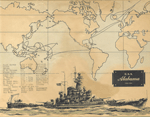 | 213k | Port broadside view anchored in Puget Sound following refit. Note the angles of 16 inch barrels showing their independent elevation capabilities, 15 March 1945. | BuShips photo #80757, courtesy of David Buell. Photo i.d. courtesy of David C. Nilsen, CTR USA, TRADOC. |
|
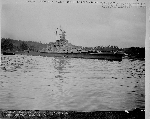 | 548k | Bow view, starboard side of the Alabama (BB-60). | USN photo # 1322-45, courtesy of David Buell. | |
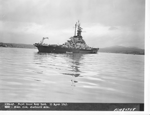 | 558k | Stern view, starboard side of the Alabama (BB-60) in March 1945 after her last wartime overhaul at Puget Sound. | USN photo # 1324-45 courtesy of David Buell. | |
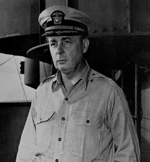 | 116k | Capt. William Barnard Goggins 18 January 1945 – 26 November 1945. He was the Executive Officer of the Marblehead (CL-12), participating in the Battle of the Java Sea in 1942. The ship sustained heavy damage in action against the Japanese. XO Goggins was severely burned and was awarded the Purple Heart as a result of his injuries. He and other casualties were landed on Java while the Marblehead limped home. By the end of the month, Japanese forces were going ashore on Java, and the American sailors were hidden until the escaped to Australia aboard small craft. These adventures formed the basis for the book by James Hilton and a movie, "The Story Of Dr. Wassell," which starred Gary Cooper and was produced by Cecil B. DeMille. He assumed command of the Alabama on 18 January 1945 while the ship was being overhauled at Puget Sound Navy Yard. Upon completion of that task and training exercises she headed for the Far East where she joined the fleet at Ulithi in May 1945. The Alabama supported the operations at Okinawa and Kyushu and her gunners assisted in shooting down several Kamikaze planes. In one instance, a plane crashed only several hundred feet away. The Alabama, under his command, participated in the strikes against Japanese industrial installations, and other facilities from Honshu to Hokkaido. On one occasion her principle target was an engineering works about fifty miles north of Tokyo and after the surprise attack and shelling of more than one thousand five hundred tons of explosives the Alabama later learned she had done a very handsome job of demolishing the targets assigned her. He was awarded a Gold Star in lieu of a second Legion of Merit, with Combat Distinguished Device "V" for Meritorious service as Commanding Officer of the Alabama from April 28, 1945 to August 3, 1945. "....The performance of his ship was exemplary during the 17 - 18 July 1945, in the bombardment of Hitachi, Honshu, Japan, during which the damages inflicted by his ship on the assigned target was the subject of special commendation by the Task Unit Commander..." Additional CO's would be: Pierce, Edward Harris, CAPT 6 [26.11.1945 / 12.08.1946] Bailey, Claude Fenn, CDR 7 [12.08.1946 / 20.08.1946] Phillips, Charles B., CAPT 8 [20.08.1946 / 09.01.1947] | Photo from the War Diary USS Alabama 1942 - 1944 via Bill Gonyo. Captains text courtesy of Wolfgang Hechler & Ron Reeves (of blessed memory). |
|
 | 1.39k | Exercising her main guns. | USN photo courtesy of Pieter Bakels. | |
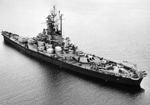 |
2.89k | All armed, open and ready for the start of the business day. | USN photo courtesy of Pieter Bakels. | |
 |
1.64k | Stern view of the business end of a southern belle. | USN photo courtesy of Pieter Bakels. | |
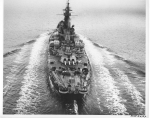 | 402k | Stern view of the Alabama (BB-60) in March 1945 after her last wartime overhaul at Puget Sound. | USN photo # 80189 courtesy of David Buell. | |
 |
2.07k | Overhaul finished in March 1945 after her last wartime overhaul at Puget Sound. | USN photo courtesy of Pieter Bakels. | |
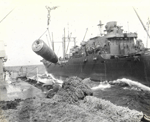 | 772k | 5 photo PDF circa 1945 of life onboard the Alabama (BB-60). | Photos courtesy of former CPhM Roy Gunnels of blessed memory via Curtis Barber. | |
 | 67k | The Alabama (BB-60) inboard profile, 1945. | Photo & text courtesy of U.S. Battleships: An Illustrated Design History by Norman Friedman. | |
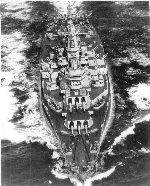 |
589k | Taken in 1945. Note the SC-1 Seahawks atop her catapults, the spare EDO float and her new radar outfit. | USN photo courtesy of Pieter Bakels. | |
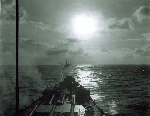 |
269k | The United States battleships Indiana (BB-58), Massachusetts (BB-59) and Alabama (BB-60) form a line ahead during target practice as seen from the South Dakota (BB-57), 1945. | USN photo courtesy of Pieter Bakels. | |
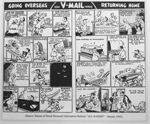 016060m | 1.01k | Explanation of V-Mail System in Display aboard Alabama (BB-60). | Data courtesy of Tommy Trampp via wikipedia.org. | |
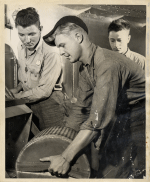 | 63k | Navy men operate big gun. G.W. Ryder, seaman, second class, of Meridan, Idaho, operates the scuttle of a big gun for powderman F. L. McCain, of Freetown, Ind., on their Pacific ship, the Alabama (BB-60), now at Tokyo. | USN photo # 1016203, courtesy of Mitch Ryder. | |
| Postwar - Present |
||||
 | 868k | Aerial view of Alabama (BB-60), 10 September 1945 as she left Pearl Harbor for the States. | USN photo #355416, courtesy of David Buell. | |
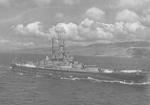 | 212k | Alabama (BB-60) arriving at San Francisco after wars end in 1945. | USN photo courtesy of David Buell. | |
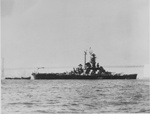 | 565k | Alabama (BB-60) perhaps taken sometime in 1945 near the Golden Gate. | USN photo courtesy of Barbara Vinsant. | |
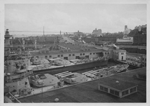 016043 |
383k | Massachusetts (BB-59) (foreground) and Alabama (BB-60) in San Francisco, early 1946. Notice in bottom left foreground the anemometer cup and windvane on the yardarm of Indiana (BB-58). | Photo courtesy of Battleship Cove via Yu Chu. | |
 | 158k | 17 March 1946. The Indiana (BB-58), Massachusetts (BB-59) & Alabama (BB-60) tied up at the Embarcadero, San Francisco. | USN photograph courtesy of Pieter Bakels. Text courtesy of ussindianabb58.com. | |
 016038 | 4.62k | A graphic of the cruises of the Alabama (BB-60). It was found among pictures belonging to my late father-in-law, CPhM Roy Gunnels, Jr., who served briefly aboard the Alabama from July to October 1946. | Photo courtesy of Curtis Barber. | |
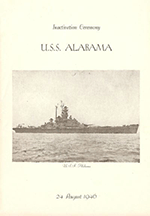 | 861k | Three page PDF of the Alabama (BB-60) inactivation ceremony on 21 August 1946. | Photos courtesy of former CPhM Hama Roy Gunnels, Jr via Curtis Barber. | |
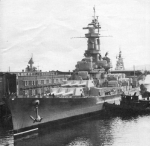 | 102k | The Alabama (BB-60) is seen tied up to pier 90 at Puget Sound Navy Yard in September, 1946. Directly behind her is the Bunker Hill(CV-17). The foremast and bridge of either the Colorado (BB-45) or Maryland (BB-46) is moored several piers away. | Courtesy of Mike Green from Leeward Publications/ SHIP'S DATA (2 & 3) Naval Supply News, Volume 5, No. 18, 6 September 1946 by the U.S. Naval Station at Seattle, Washington. | |
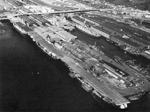 | 497k | U.S. Navy ships at Seattle, Washington, on 9 January 1947. Three aircraft carriers are at Pier 91, Bunker Hill (CV-17), Bon Homme Richard (CV-31) and Essex (CV-9). Ticonderoga (CV-14) is at Pier 92. The battleships Indiana (BB-58) and Alabama (BB-60) are moored opposite of the Ticonderoga . | USN photo 80-G-373247 from the Essex (CVS-9) 1967 cruise book via Robert Hurst. | |
 | 1.10k | Puget Sound NSY around 1948. There are five mothballed Essex class (CV-9) carriers at the left. To the right of the carriers are five battleships. I believe they are Alabama (BB-60), West Virginia (BB-48), Maryland (BB-46), Indiana (BB-58), Colorado (BB-45). | USN photo courtesy of Joe MacDonald. | |
> | 570k | Four mothballed battleships at Puget Sound Naval Shipyard in 1948. Left to right: Alabama (BB-60), West Virginia (BB-48), Indiana (BB-58) & Colorado (BB-45). | Photo courtesy of Joe MacDonald. | |
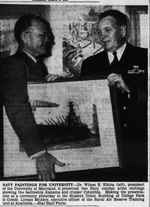 016049 |
NR | NAVY PAINTINGS FOR UNIVERSITY Dr. Wilson H. Elkins (left), president of the University of Maryland, is presented two Navy combat artist etchings showing the battleship Alabama (BB-60) and cruiser Columbia (CL-56). Making the presentation at a ceremony yesterday in the Student Union Building at College Park is Comdr. Lyman McAboy, executive officer of the Naval Air Reserve Training unit at Anacostia. | Image and text provided by Library of Congress, Washington, DC. Evening Star. [volume](Washington, D.C.) 1854-1972, 08 March 1956, Image 30, courtesy of chroniclingamerica.loc.gov. | |
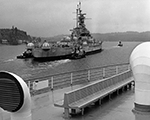 |
967k | On 18 June 1964, as seen from the deck of a Washington State ferry, Ex-Alabama (BB-60) is towed into Puget Sound out of Sinclair Inlet on the start of her last voyage to Mobile, Alabama, where she will serve as a museum ship. | Source: Naval History and Heritage Command, Photo No. L45-04.01.01 via Mike Green. | |
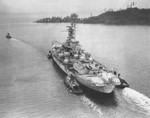 | 498k | Bremerton, Washington (22 June 1964). The 35,000-ton ex-Alabama (BB-60) aided by tugs moves across Puget Sound to Seattle. After installation of towing gear she will head for Mobile, Ala., via the Panama Canal, to create the Battleship Alabama Memorial Park. This view shows a temporary work shack on deck, next to turret #3. She was stricken from the Naval Register on 1 June 1962 and donated to the Battleship Alabama Commission on 16 June 1962, after $100,000 in public fund-raising was added to corporate money to complete the 1-million dollar donation for the ship. The turn over ceremony will be held in Seattle on 7 July 1964. | AP Wire photo courtesy of Robert M. Cieri. | |
 | 133k | Citizens of the state of Alabama had formed the "Alabama (BB-60) Battleship Commission" to raise funds for the preservation of Alabama as a memorial to the men and women who served in World War II. The ship was awarded to that state on 16 June 1964, and was formally turned over on 7 July 1964 in ceremonies at Seattle. Alabama was then towed to her permanent berth at Mobile, Ala., arriving in Mobile Bay on 14 September 1964. She is seen being towed through the Panama Canal on her way from Seattle to Mobile sometime in the summer of 1964. | Photograph courtesy of Robert M. Cieri. Text courtesy of DANFS. | |
 | 118k | Alabama (BB-60) being towed through the Panama Canal on her way from Seattle to Mobile sometime in the summer of 1964. Note the secondary stern armament wrapped in their protective "dehumidifiers". | Photograph courtesy of Robert M. Cieri. | |
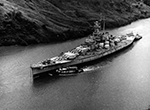 | 353k | Alabama (BB-60) moves through Gaillard (Culebra) Cut with tugs to port and stern. Photographed by Helrauth, 26 August 1964. | Photo # 428-GX-USN-1105620-C courtesy of National Museum of the U.S. Navy via flickr.com. | |
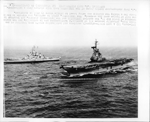 | 278k | (13 September 1964.) A RARE SIGHT Aircraft carriers and battleships aren't seen together at sea these days, primarily because all of America's battlewagons are in mothballs. But two historic veterans of WW II, the Lexington (CV-16) & Alabama (BB-60) got together in the Gulf of Mexico over the weekend. The Lexington, still in service, was enroute to New Orleans for a visit, the Alabama was being towed to Mobile where she will be enshrined. | Official USN photo by Gordon Jones via AP Wire photo, courtesy of Ron Reeves (of blessed memory). | |
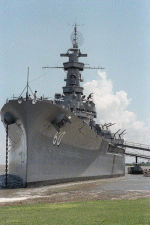 | 406k | A port bow view of the memorial Alabama (BB-60) at Battleship Park, Mobile, Ala., 1 January 1980. | Official USN photo # DN-SC-86-04751 by PH1 Dave MaClean from the the Department of Defense Still Media Collection, courtesy of dodmedia.osd.mil. | |
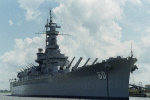 | 271k | A starboard bow view of the memorial Alabama (BB-60) at Battleship Park, Mobile, Ala., 1 January 1980. | Official USN photo # DN-SC-86-04749 by PH1 Dave MaClean from the the Department of Defense Still Media Collection, courtesy of dodmedia.osd.mil. | |
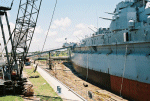 | 213k | Portside bow view of the Alabama (BB-60) with the water from the cofferdam having been drained and hull repairs being made on the ship, at Battleship Park, Mobile, Ala. | Courtesy of Judson Phillips. | |
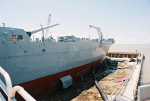 | 140k | Portside stern view of the Alabama (BB-60) with the water from the cofferdam having been drained and hull repairs being made on the ship, at Battleship Park, Mobile, Ala. | Courtesy of Judson Phillips. | |
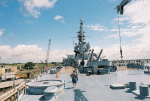 | 170k | Stern view of the Alabama (BB-60) at Battleship Park, Mobile, Ala. | Courtesy of Judson Phillips. | |
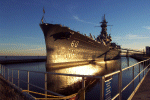 | 133k | The rays of sunset shine off the Alabama (BB-60) in this 28 January 2004 photo. | Photo i.d. courtesy of Mike McCants. Photo courtesy of Jim Richardson. | |
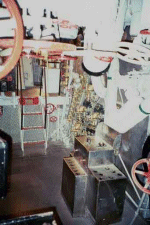 | 34k | One of the engine rooms aboard the Alabama (BB-60). | Courtesy of Robert Hall. | |
 | 23k | Dedication Plaque for Alabama's (BB-60) main battery | Courtesy of Robert Hall. | |
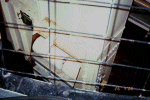 | 34k | Powder Bag Elevator for Main Battery of the Alabama (BB-60). | Courtesy of Robert Hall. | |
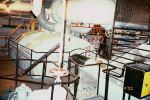 | 44k | Main engine steam turbine, 1 of 4. | Courtesy of Robert Hall. | |
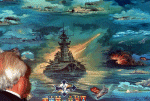 | 376k | A guest studies a painting depicting the history of battleships. The artwork was painted by George Skybeck and presented to the Pearl Harbor Survivors Association during their annual banquet at Honolulu, Hawaii, on 8 December 1991. | USN photo # DN-SC-92-05391, by PHC Carolyn Harris, courtesy of dodmedia.osd.mil, Official USN photo . | |
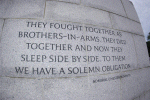 | 371k | A quote made by Fleet Adm. Chester W. Nimitz is inscribed on a granite wall at the National World War II Memorial located on the National Mall in Washington, D.C. Fleet Adm. Nimitz was the United States signatory to the surrender terms aboard the battleship Missouri (BB-63) in Tokyo Bay, Japan on September 2, 1945, thus ending World War II. Established by the American Battle Monuments Commission, the memorial honors all military veterans of World War II, the citizens on the home front, the nation at large, and the high moral purpose and idealism that motivated the nation's call to arms. On May 29, 2004, the memorial was formally dedicated with an estimated 200,000 people expected to attend, and includes 100,000 visiting veterans of all wars. | USN photo N-0295M-011 by Photographer's Mate 2nd Class Daniel J. McLain, courtesy of news.navy.mil. | |
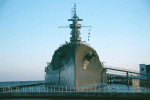 | 89k | Bows on view of the Alabama (BB-60), she has a slight list to port as she is sitting in the mud - no floating ship here, she's grounded after Hurricane Katrina's visit to the Southeast of the U.S., July 2005. | Photo & text courtesy of Larry Lee, RM1, USN/Ret. | |
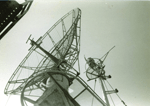 | 463k | SK3 Radar Antenna. | Photo by Alan Raven courtesy of Pieter Bakels. | |
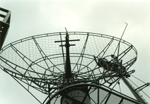 | 1.10k | SK3 Radar Antenna size wise in real life. | Photo by Alan Raven courtesy of Pieter Bakels. | |
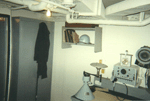 | 78k | Captain's sea cabin, 2009. | Photo by Joe Sandling, courtesy of Pieter Bakels. | |
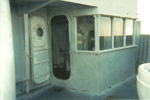 | 72k | Navigating Bridge, 2009. | Photo by Joe Sandling, | |
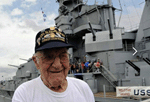 | 276k | Alabama (BB-60) veteran Raymond Weigand Jr. after visiting it during the Crewmen's Association Reunion on 13 April 2019. | Photo & text courtesy of Yu Chu. | |
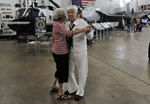 | 311k | Will Rozum and his wife, Mary Lou Rozum, dance to a classic tune sung by the Blue Anchor Belles during the 2019 Alabama (BB-60) Crewmen's Association Reunion on 13 April 2019. | Photo & text courtesy of Yu Chu. | |
| Commanding Officers | ||
| 01 | CAPT. Wilson, George Barry, USN (USNA 1914) :RADM | 16.08.1942 - 17.03.1943 |
| 02 | CDR. Dietrich, Neil Kittrell, USN (temporary) (USNA 1923) :RADM | 17.03.1943 - 20.03.1943 |
| 03 | CAPT. Kirtland, Fred Durrel, USN (USNA 1916) :VADM | 20.03.1943 - 12.08.1944 |
| 04 | CAPT. Murphy, Vincent Raphael, USN (USNA 1918) :VADM | 12.08.1944 - 14.11.1944 |
| 05 | CAPT. Riggs, Ralph Smith, USN (USNA 1918) :VADM | 14.11.1944 - 18.01.1945 |
| 06 | CAPT. Goggins, William Bernard, USN (USNA 1920) | 18.01.1945 - 26.11.1945 |
| 07 | CAPT. Pierce, Edward Harris, USN | 26.11.1945 - 12.08.1946 |
| 08 | CDR. Bailey, Claude Fenn, USN | 12.08.1946 - 20.08.1946 |
| 09 | CAPT. Phillips, Charles B., USN | 20.08.1946 - 09.01.1947 |
The contact listed, Was the contact at the time for this ship when located. If another person now is the contact, E-mail me and I will update this entry. These contacts are compiled from various sources over a long period of time and may or may not be correct. Every effort has been made to list the newest contact if more than one contact was found.
| Back To The Main Photo Index | Back To The Battleship Photo Index Page |